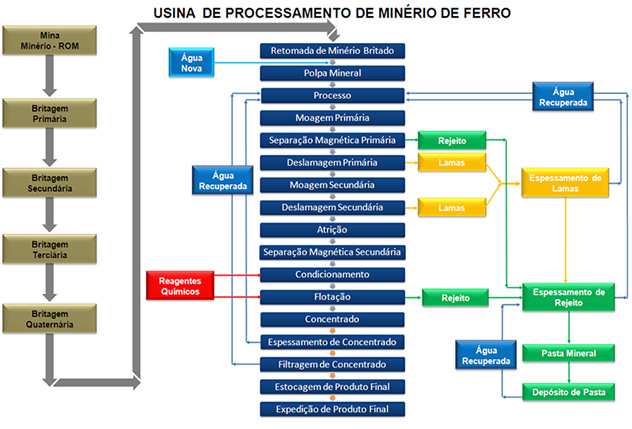Processing and Refining Stages

The grinded material is processed in accordance with the following stages: re-crushing, de-mudding, flotation, concentrate thickening, mud thickening, re-grinding, pulp transportation via mining pipeline, screening and stockpiling. The main functions of each of these interconnected stages is shown below.
Re-crushing
Re-crushing has the function of grinding the material to a finer granulometry, of around 25mm, to allow roll press feeding. The re-crushed product is screened and what’s retained in the screen is returned to re-crushing. The material that passes through the screen moves on to the pressing stage described below.
Pressing
Pressing is responsible for reducing the size of the material. The material that passes through the screening moves on to the roll press silos whence it’s extracted to feed the press. If a metal is detected, the divider is triggered and the flow containing the metal is deviated from the roll press and sent to grinding
Grinding
The product from pressing moves on to the grinding stage through chain transporters, and ore grinding is carried out. Grinding of the ore is needed to obtain a granulometry that’s appropriate to the concentration process used (flotation) as well as to release the minerals to be separated (iron and silicon). Grinding is performed in a closed circuit with classification, where the underflow returns to the grinding (circulating load) and the overflow moves to de-mudding.
De-mudding
De-mudding is performed in two stages, primary and secondary de-mudding. The overflow from primary de-mudding moves on to secondary de-mudding. The overflow from secondary de-mudding moves on to the mud thickener. The underflow moves on for flotation conditioning, along with the primary de-mudding underflow.
Flotation
The underflow from de-mudding moves on to the flotation conditioners, where there is an addition of jellified amido and caustic soda. The amido acts as an iron depressor and the soda adjusts the pulp’s Ph. After the time needed for conditioning (10 minutes), there is an addition of amines into the conditioner’s discharge pipe. Amines are silicon collectors and foamers.
Flotation is composed of five stages, which result in two products: a final concentrate which moves on to re-grinding and then to thickening, and a final reject, which is thickened for recovery of process water and later moved on for reject retention.
Re-grinding
The final concentrate flotation moves on to the re-grinding stage to adjust the granulometry of the pulp to feed the mining pipeline The re-grinding works in closed circuit. The underflow of the classification consists of the product’s circulating load and the overflow moves on for spacing of the concentrate.
Concentrate Thickening
The final, re-grinded concentrate moves on to be fed to the concentrate thickener, so as to adjust the percentage of solids for transportation through mining pipeline, which carries out a recovery of the water. The underflow of the concentrate thickening moves on to the expedition tanks of the mining pipeline and the overflow is recovered water to be reused at the plant, as process water.
Reject thickening
The overflow from de-mudding and the reject from flotation moves on to feed the reject thickener to adjust the percentage of solids, and permit recovery of water before moving on reject retention. The underflow from reject thickening moves on the rejects retainer and the overflow becomes water recovered for reuse in the plant, as process water.
Pulp transportation via mining pipeline
The underflow from the concentrate thickener moves on the expedition tanks of the mining pipeline where it remains for 6 hours. The pulp is transported by mining pipeline through positive displacement pumps, and moves on to the Mangue Port. The Mangue Port has tanks for receiving the pulp via mining pipeline so as to adjust the thickening feeding and port screening.
Screening and stockpiling of products
From the mining pipeline reception tanks, the pulp is pumped into the concentrate thickener so as to adjust the percentage of solids to be fed into screening. The underflow from concentrate thickening moves on to screening and the overflow is directed into the clarifying thickener.
Screening is performed in ceramic screens (ceramic). The tart is the produced pellet feed that moves on for stockpiling. The screened material moves on into the clarifying thickener, along with the concentrate thickener overflow. The thickener underflow returns to the concentrate thickener and the overflow moves on to an Industrial Effluents Treatment Station
The pellet feed is stockpiled and returned to the product atrium through Stacker-Reclaimer.

